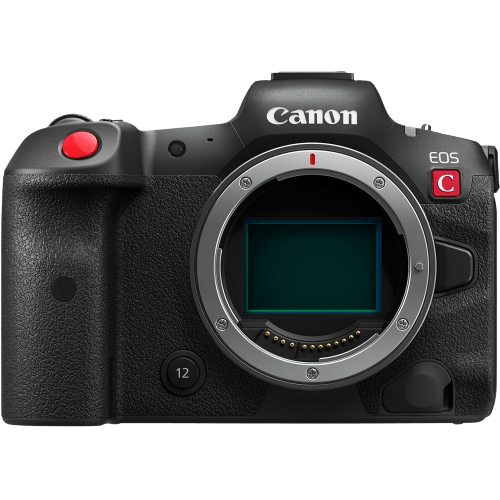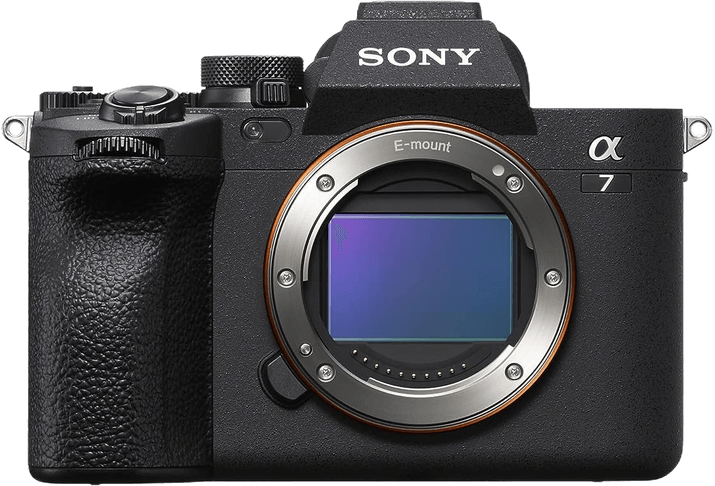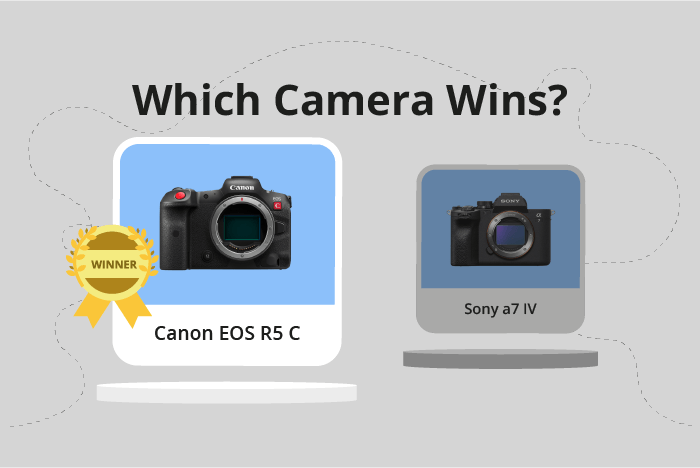Canon EOS R5 C vs Sony a7 IV Comparison
Canon EOS R5 C

Sony a7 IV

The Canon EOS R5 C takes the lead with a score of 87/100, while the Sony a7 IV trails slightly behind with 84/100. Both mirrorless cameras share similarities, such as their announcement and release years of 2021 and 2022, respectively. However, the Canon R5 C stands out with its higher launch price of $4499, compared to the Sony a7 IV’s $2499.
The Canon EOS R5 C also boasts a larger size (142 x 101 x 111mm) and heavier weight (770g) than the Sony a7 IV (131 x 96 x 80mm and 659g). This difference suggests that the Canon model may offer more advanced features and better performance. On the other hand, the Sony a7 IV’s lower price and smaller size make it a more budget-friendly and portable option for photographers.
Taking these factors into account, the Canon EOS R5 C is the superior choice for those seeking top-notch performance and features, while the Sony a7 IV caters to those who prioritize affordability and portability.
Canon EOS R5 C vs Sony a7 IV Overview and Optics
The Canon EOS R5 C outperforms the Sony a7 IV in optics with a score of 88/100 compared to the Sony’s 85/100. Both cameras share several specifications, including a CMOS sensor, full-frame sensor size, image stabilization, and a DXOMARK score of 97 for the sensor. However, the Canon EOS R5 C excels in certain areas, giving it the edge over the Sony a7 IV.
The Canon EOS R5 C boasts an impressive 45 megapixels, compared to the Sony a7 IV’s 33 megapixels. This difference allows the Canon camera to capture more detail and produce higher-resolution images. Additionally, the Canon EOS R5 C features a faster shooting speed of 20 frames per second, double the Sony a7 IV’s 10 frames per second. This advantage enables the Canon camera to capture fast-moving subjects more effectively and efficiently.
The Sony a7 IV, while not surpassing the Canon EOS R5 C in optics, still offers a strong performance. It shares the same sensor quality as the Canon, with a DXOMARK score of 97. The Sony camera also utilizes the reputable Bionz XR processor, ensuring fast and accurate image processing.
In terms of lens mounts, the Canon EOS R5 C uses the Canon RF mount, while the Sony a7 IV uses the Sony FE mount. Both mounts offer a wide range of high-quality lenses, providing photographers with numerous options for various shooting scenarios.
The comparison reveals that the Canon EOS R5 C offers superior optics with a higher megapixel count and faster shooting speed. However, the Sony a7 IV remains a strong contender with its high-quality sensor and image processing capabilities. Ultimately, both cameras provide excellent optical performance, with the Canon EOS R5 C holding a slight advantage.
Canon EOS R5 C vs Sony a7 IV Video Performance
The Canon EOS R5 C outperforms the Sony a7 IV in video capabilities, scoring 100/100 compared to Sony’s 91/100. Both cameras share some common features, such as a maximum video frame rate of 120fps and built-in time-lapse functionality. However, the Canon R5 C offers superior video resolution and dimensions, making it the preferred choice for videographers seeking top-quality performance.
The Canon EOS R5 C boasts an impressive maximum video resolution of 8K, with dimensions of 8192 x 4320. This high resolution enables the capture of incredibly detailed and crisp footage, providing filmmakers with a versatile camera for various shooting scenarios. On the other hand, the Sony a7 IV has a maximum video resolution of 4K and dimensions of 3840 x 2160. While still producing high-quality footage, it falls short when compared to the Canon R5 C’s 8K capabilities.
Despite its lower score, the Sony a7 IV is not without its merits. Its 4K video resolution is still considered excellent for most applications, and it shares the same 120fps frame rate and time-lapse functionality as the Canon R5 C. This makes it a reliable and capable choice for many videographers, especially those who may not require the extra resolution provided by the Canon R5 C.
Comparing the video capabilities of the Canon EOS R5 C and the Sony a7 IV reveals a clear winner in the Canon R5 C, with its superior 8K video resolution. However, the Sony a7 IV remains a strong contender with its 4K video resolution and shared features. Ultimately, the choice between these two cameras will depend on the specific needs and preferences of the videographer.
Canon EOS R5 C vs Sony a7 IV Features and Benefits
The Canon EOS R5 C wins the features comparison with a score of 87/100, while the Sony a7 IV scores 83/100. Both cameras share several specifications, such as having a touchscreen, flip screen, WiFi, Bluetooth, and no GPS.
The Canon EOS R5 C outperforms the Sony a7 IV in terms of screen size and resolution. The R5 C boasts a 3.2-inch screen with a resolution of 2,100,000 dots, providing a clearer and larger display for better image preview and menu navigation. This advantage enhances the user experience and allows for more precise adjustments when composing shots.
On the other hand, the Sony a7 IV still offers competitive features despite its lower score. With a 3-inch screen and a resolution of 1,040,000 dots, it provides a sufficient display for most users. Although the screen resolution is lower than the Canon EOS R5 C, the Sony a7 IV maintains its position as a strong contender in the market with its other capabilities.
To conclude, the Canon EOS R5 C takes the lead in the features comparison due to its larger and higher-resolution screen. This superiority results in a more enjoyable user experience and better image preview capabilities. However, the Sony a7 IV remains a viable option for those who do not prioritize screen size and resolution, as it shares many other essential features with the Canon EOS R5 C.
Canon EOS R5 C vs Sony a7 IV Storage and Battery
The Sony a7 IV outperforms the Canon EOS R5 C in storage and battery with a score of 76/100 compared to the Canon’s 68/100. Both cameras possess two memory card slots and support USB charging. They also share compatibility with SD (UHS-II) memory cards.
The Sony a7 IV holds an advantage with its longer battery life of 580 shots, compared to the Canon EOS R5 C’s 320 shots. Additionally, the Sony a7 IV accepts CFexpress Type A cards, adding versatility in storage options.
The Canon EOS R5 C, on the other hand, offers compatibility with CFexpress B cards, which may be beneficial for some users. However, this does not outweigh the advantages of the Sony a7 IV.
Considering the longer battery life and broader memory card compatibility, the Sony a7 IV proves to be the superior choice in terms of storage and battery performance.
Canon EOS R5 C vs Sony a7 IV – Our Verdict
Are you still undecided about which camera is right for you? Have a look at these popular comparisons that feature the Canon EOS R5 C or the Sony a7 IV:

